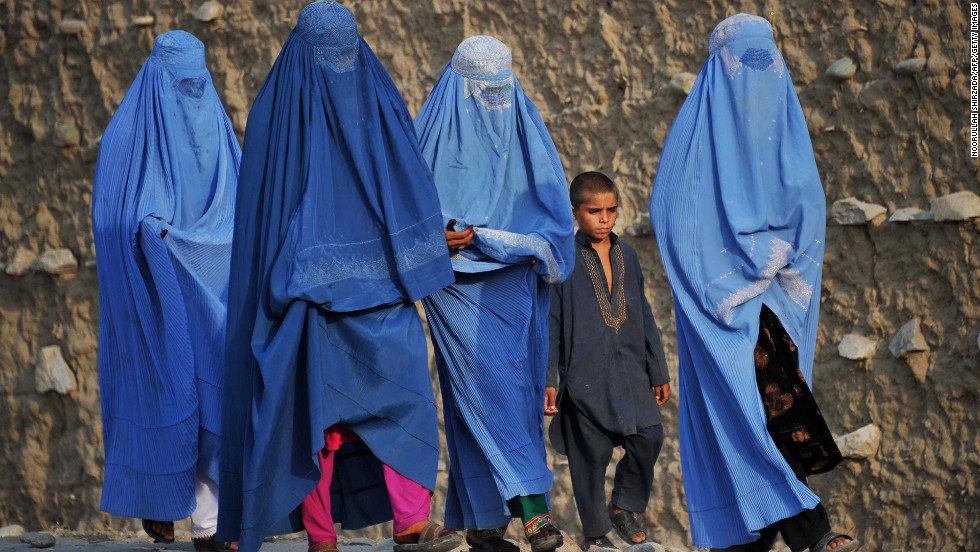What is the traditional clothing of Afghanistan? There has been major push back amongst the more conservative people of Afghanistan to have traditional dress become the mainstream within the Afghan fashion scene. This type of style consists of flowy and loose garments that cover a majority of the body like. . .
Women:
Tunbaan ⇢ this is a a loose pant that reaches the ankles under a dress or tunic.
Chador/Hijab ⇢ head covering or headscarves are common and used to cover the woman's hair.
 Burqa ⇢ today, only the ultra-conservative women will wear the burqa, which was once mandatory while under Taliban control (see previous post).
Burqa ⇢ today, only the ultra-conservative women will wear the burqa, which was once mandatory while under Taliban control (see previous post).

Formal ⇢ Women will wear a tunbaan with intricate designs and embroidery along with some bling; this bling can vary based on the region, but tiny, sewn on mirrors are common.

Men:
Peraahan Tunbaan ⇢similar to the woman's tunbaan, but consists of a shirt and pants with a cloth cord called a azaarband that holds the clothes in place
 Lungee⇢ Turbans are the most common head covering that men will traditionally wear in Afghanistan, and each region has a different, unique way of wrapping their turban. Often times, a man's head covering will indicate status. For example, Afghan royalty often wore a sheep-fur, triangular shaped hat called a karakul hat.
Lungee⇢ Turbans are the most common head covering that men will traditionally wear in Afghanistan, and each region has a different, unique way of wrapping their turban. Often times, a man's head covering will indicate status. For example, Afghan royalty often wore a sheep-fur, triangular shaped hat called a karakul hat.

Formal⇢ Men will wear a vest that is embroidered over top their peraahan. A coat, chapan, can be worn over all of it.

Women:
Tunbaan ⇢ this is a a loose pant that reaches the ankles under a dress or tunic.
Chador/Hijab ⇢ head covering or headscarves are common and used to cover the woman's hair.


Men:
Peraahan Tunbaan ⇢similar to the woman's tunbaan, but consists of a shirt and pants with a cloth cord called a azaarband that holds the clothes in place

Formal⇢ Men will wear a vest that is embroidered over top their peraahan. A coat, chapan, can be worn over all of it.
The clash between the modern and tradition has been an ongoing culture clash within Afghanistan. Prior to the Taliban, women could be seen wearing very western clothing like pencil skirts, blouses, and heels. For an American, the sight would have been something very familiar. However, upon their rise to power in the 1990s, the country did a 180 and returned to extremely conservative dress as a part of mandatory Taliban decree. Then, in 2001, American troops forced the Taliban out of power and instituted a reconstruction process that has been in place since. There is currently a back and forth as to abide by social customs of traditional clothing, being clad with a tunbaan and headscarf or hijab, or place a preference of personal expression and wear more modern clothing. Many fashion designers have begun making clothes that combine the two, forming western clothing with the traditional shape and embroidery of Afghanistan all for a new generation. The next post will highlight the designers who are making this possible.
This is very interesting! This modern-traditional clash seems to be common in many Islamic areas now. In Algeria, this clash is apparent on many different topics as well. For example, when researching rai music, I found that while it had been very popular during the Algerian Revolution, more traditional music was pushed to the forefront after Algeria gained their independence from France. However, rai is still an important part of their society, though it isn't common in public areas. Clothing wise, Algeria faced a more traditional push during its civil war just like you described with the Taliban in Afghanistan. On the subject of meshing the traditional with the modern, what exactly do you mean when you say that designers are combining the traditional and western clothes? How does one combine the shape of traditional Afghanistan dress with western clothing, such as a pencil skirt and blouses? Hope to read more posts from you soon!
ReplyDelete